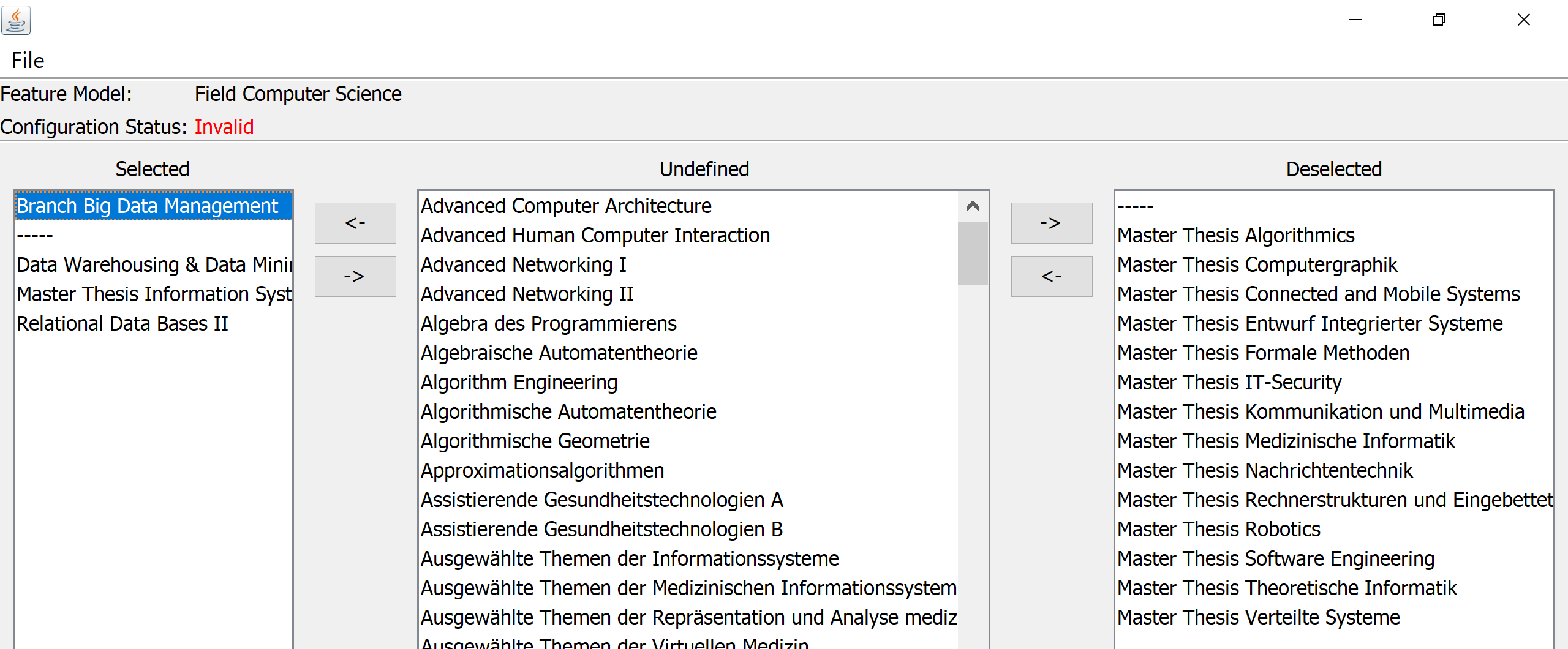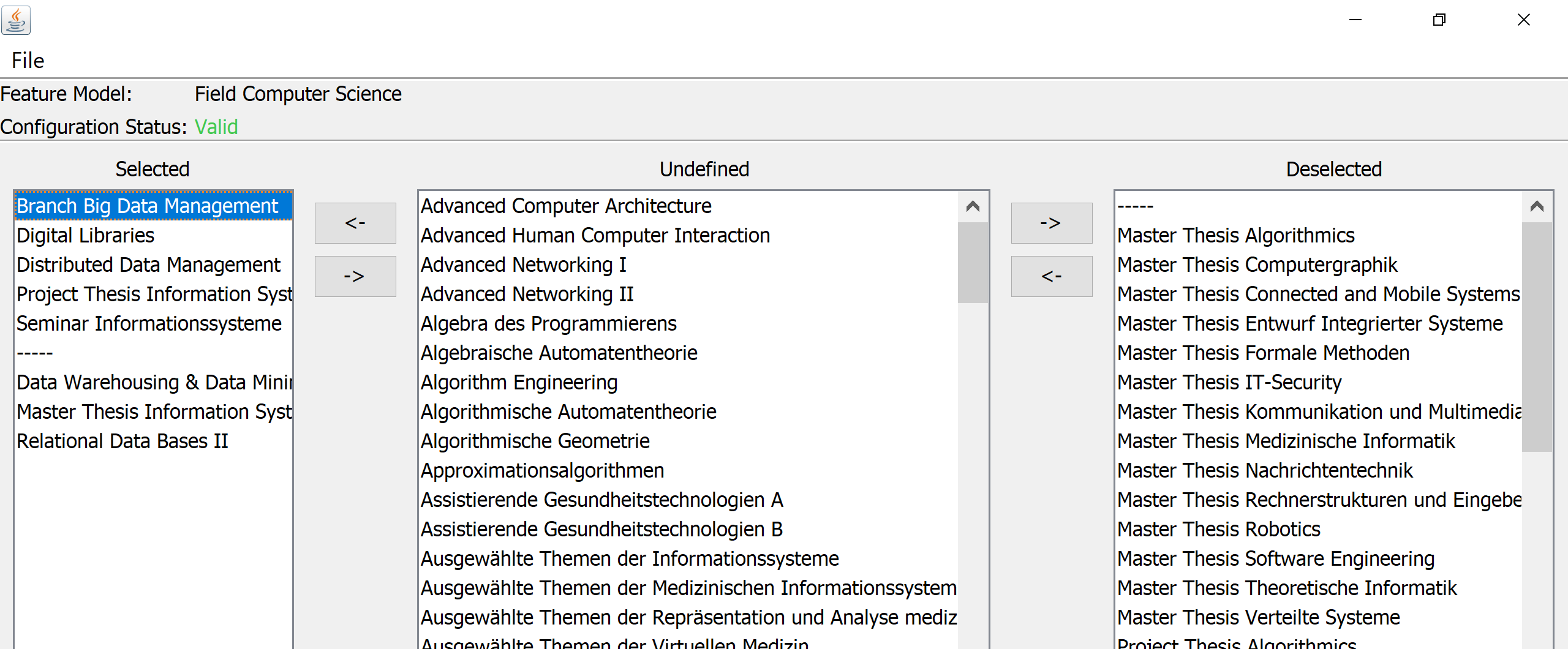BroT
encoding at-most-k constraints in boolean logic to help students in configuring branches of study
Origins and Overview
This project was an idea of my PhD supervisor Thomas. Back when I was in my master’s at the Technical University Braunschweig, he was looking for a student to help in encoding the university’s constraints for branches of study in computer science. The premise is the following:
- In the computer science masters back then, you could choose a specialization such as algorithm engineering, database engineering, visual computing, and so on, called branches of study. To specialize, you had to select courses and lectures according to specific constraints, such as “at least 20 credit points must be achieved from this subset of computer vision lectures”. The constraints of each branch of study were defined in natural language on the universities website. Of course we found inconsistencies, ambiguities, and false-optional courses (i.e., a course may be flagged as optional, yet you must take it to satisfy the constraints).
- Thomas was one of the lead developers of FeatureIDE, basically a reasoning-framework for boolean constraints, including an editor for feature models to model constraints graphically (and more things but these are not important for our story here). So Thomas’ idea was to reuse the reasoning engine to (1) formalize the branches of study, and (2) develop a configurator for students so they could see what courses to take (even if they already had taken some but not all relevant courses) and so on.
So I started working on this in terms of a project thesis, which later turned out into a paper (Bittner et al., 2019).
A Domain-Specific Language for Branches of Study
The first thing I did was to develop a domain-specific language (DSL) for branches of study. The DSL featured german keywords so that the administrative staff could write their own branches (which of course never happened). The DSL also came with editor support in Eclipse. Below is a small excerpt for the branch of Big Data Management, one of the simplest branches of study. Other branches were much more involved and the DSL also featured ways to specify the set of courses and their credit points and so on.
Studiengang "Computer Science"
Studienrichtung "Branch Big Data Management"
Pflicht
"Relational Data Bases II"
"Data Warehousing & Data Mining Techniques"
"Master Thesis Information Systems"
Wahlpflicht 30 CP
"Project Thesis Information Systems"
"Seminar Informationssysteme"
"Digital Libraries"
"Spatial Databases and Geo-Information Systems"
"Distributed Data Management"
"Wissensbasierte Systeme und deduktive Datenbanksysteme"
"Multimedia-Datenbanken"
"Information Retrieval & Web Search"
"Ausgewählte Themen der Informationssysteme"
Compiling to Feature Models and Boolean Logic
Second, I developed a compiler that converts expressions of my DSL to feature models, a graphical constraint language based on boolean logic. The idea was that in the DSL, it would be easy to specify constraints where you have to select a subset of courses to reach a certain amount of credit points (Wahlpflicht), where it is hard to to the same in boolean logic - causing an exponential blowup in the worst case. Indeed, in the following feature model, the second constraint is cut off (...) because it is way too long.

Configuration App for Students
Finally, based on a demo implementation by Thomas, I developed a small graphical configuration application for students to determine which courses they would like to attend and for which branches they would be eligible. The tool could also tell students which courses to select to make a certain branch and so on. In the background, this was reusing the configuration engine of FeatureIDE, which uses decision propagation for these purposes. For example, in the following picture, the student decided to take the Big Data Management branch of study (hence it is shown in the Selected column). BroT then automatically selected mandatory courses and also deselected courses that must not be taken, which in this case means the student cannot write a master’s thesis on another topic. The Configuration Status on the top left shows that the student has not yet reached a state that describes an actual valid course set for a master in computer science (i.e., this is partial configuration):

When selecting more available courses from the center Undefined column, the student can reach a valid state, and be assured that taking the courses in the left column will definitely end in having specialized on big data management:

Maybe I over-engineered the whole process a bit but for sure it was fun.
Conclusion
In the end, the compilation and configuration did not scale well because of the aforementioned combinatorial explosion. While I could compile all branches, configuring some of them was just not feasible because the formulas were just too massive for the SAT solver. Using a better language such as higher-order logic and SMT solvers would have been more appropriate I guess but we wanted to see if we could reuse the FeatureIDE tooling for this particular problem without having to develop all the infrastructure from ground up.
So what’s in here for you?
The compilation process is outlined in detail in our paper (Bittner et al., 2019). Here, we also explain how to encode at-most-k constraints based on a range of encodings from the literature, and we also present our own meta at-most-k encoding.
If you are interested in reusing the encoding implementation, please check out our example repository on how to use the Java library:
If you are interested in the DSL, the compiler implementation, or the configuration tool, please head to our official BroT repository:
Oh, and BroT means Branch Of study Tool. (I wanted a cool name for the FOSD Cool Wall. Scroll down on Christian Kästner’s website to learn more about it.)